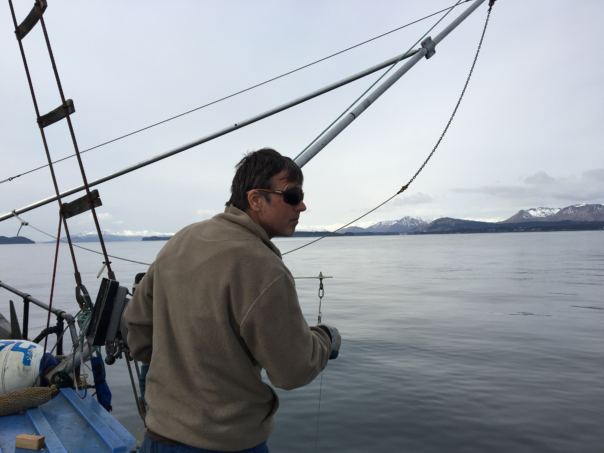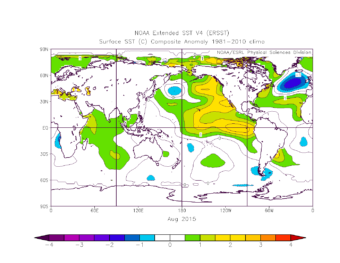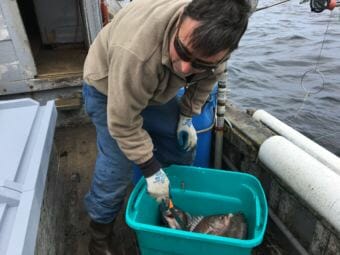
A hint of optimism creeps into Darius Kasprzak’s voice as he pilots his boat, the Marona, out of the harbor in Kodiak on a calm day in early May.
“We’re in the morning, we’re at the start of the flood tide,” Kasprzak said. “This is where you want to be.”
On the screen of Kasprzak’s echo sounder he sees a dense cluster of dots on the ocean bottom.
“Let’s drop on it,” Kasprzak said. “That looks pretty darn good.”
Kasprzak kills the engine, leaps onto the deck and lowers one of his fishing lines into the water.
And then… nothing.
For years, Alaska fishermen like Kasprzak have worried that climate change would threaten their livelihoods. Now, it has. The cod population in the Gulf of Alaska is at its lowest level on record. The culprit is a warm water mass called “the blob“ that churned in the Pacific Ocean between 2013 and 2017.

At its peak, it stretched from Alaska to South America. In the Gulf of Alaska, the cod population declined by more than 80 percent.
Climate change didn’t cause the blob all on its own. But scientists say global warming made it worse, pushing warm ocean temperatures to the extreme.
Kasprzak says he used to think the rich ocean ecosystem he fishes was unshakable. But he’s mostly given up on finding more cod here.
“We’ve just seen now that even the mighty Gulf of Alaska, how fragile it actually is, when all you’ve got to do is warm it up,” Kasprzak said. “You don’t even have to warm it up that much, a couple of degrees. It doesn’t take that much.”
Since early 2017, the temperature of the Gulf of Alaska has been close to normal. Now everyone in Kodiak is asking: Will the cod come back?

Mike Litzow is trying to answer that question. He’s a fisheries biologist who works for the University of Alaska, based in Kodiak. With his wiry frame and thick beard, he looks more like a fisherman than a scientist.
Litzow does go fishing every few weeks in the spring and summer — for science, in search of young cod. He stands in shallow water on Long Island, near Kodiak, and uses a net called a beach seine to sweep up fish hiding in the eelgrass and kelp beds.
“There’s all kinds of information you can get over time, once you catch the fish,” Litzow said.
Litzow doesn’t find any cod in this net. But by the end of the summer, he hopes to catch enough tiny cod to provide clues on whether the population will recover. He doubts it will. He thinks the cod decline may have been so steep that other fish might fill its place in the ecosystem.
“When you push a population down really hard, the resources that population used to rely on can be exploited by other populations,” Litzow said.
Other scientists are more optimistic. But everyone seems to agree on one point — that the blob is a dress rehearsal for a future with climate change. Marine heat waves are expected to happen more often and, overall, ocean temperatures will warm.
Litzow says it’s hard to predict what kind of ripple effects that will have. If you had asked a bunch of scientists to predict how fish would do during the blob years in the Gulf of Alaska, Litzow says, “it would just be like drawing names out of a hat. It’s not like all of the scientists would say cod are going to be the ones that collapse.”
Litzow says fishing communities have to get used to the prospect of more frequent shocks to the ocean ecosystem. And Kodiak certainly isn’t the only place that’s seen them. Those changes aren’t all bad, he says. When one species declines, others do well. Right now, sablefish are booming in the Gulf of Alaska.
But the cod decline could be a disaster for fishermen, and for Kodiak. Already, cod boats are traveling more than a thousand miles away to find fish. That means crews aren’t stocking up at stores in town and boats aren’t paying the local fish tax.

Out in the Gulf, Darius Kasprzak has been on his boat for more than four hours. He sees some puffins, even a whale, but no cod.
Eventually, he gives up and decides to try to catch some dusky rockfish. He lowers his line over a promising spot and quickly reels one in.
“It’s a nice one, too,” Kasprzak said, taking the fish off the hook and putting it on ice.
It’s not nearly enough to bring to a processor, but it will make several meals. Rockfish used to help Kasprzak supplement his cod earnings. Now it’s his main fishery. It doesn’t come close to making up for the cod income he’s lost, but he’s working with a local nonprofit to market rockfish directly to customers to get a better price for the fish.
Kasprzak has also considered trolling for salmon instead, but that would require an expensive new permit and gear, and many salmon runs have been weak, too. The blob could be a factor.
Kasprzak says he can’t believe how fast climate change has altered his life. He says he didn’t even know it was an issue until he watched Al Gore’s An Inconvenient Truth in 2006.
“A dozen years later, not only is it real but the climate has warmed so much and the oceans have absorbed so much heat, my industry is gone because of it,” Kasprzak said.
Kasprzak is looking at other career options. But he says he wants to stay in Kodiak as long as he can. That way if the cod do come back he’ll be one of the first ones out on the water.
This story is part of a new season of the podcast Midnight Oil from Alaska’s Energy Desk. Season two is called The Big Thaw and looks at climate change in Alaska. New episodes begin August 9.
Annie Feidt is the broadcast managing editor at Alaska Public Media. Reach her at afeidt@alaskapublic.org. Read more about Annie here.





